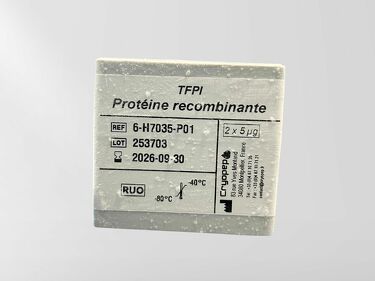Recombinant Tissue Factor Pathway Inhibitor (TFPI) – Frozen solution

| 6-H7035-P01 | Flacon | 5 µg |
| 6-H7035-P01-50 | Flacon | 50 µg |
The human TFPI protein, His-tagged (TFI-HS226), is produced in human HEK293 cells. It comprises amino acids Asp 29 to Lys 282 and carries a C-terminal polyhistidine (His) tag.
Description of the Recombinant Tissue Factor Pathway Inhibitor (TFPI) – Frozen solution
Active protein for research in hemostasis and thrombosis This biologically active, His-tagged recombinant human Tissue Factor Pathway Inhibitor (TFPI) is expressed in HEK293 cells and includes amino acids Asp29 to Lys282. The protein features a C-terminal polyhistidine tag for easy purification and detection. Recombinant Tissue Factor Pathway Inhibitor (TFPI) is optimized for:
- Functional studies
- Enzymatic assays
- Translational research in coagulation, hemostasis, and thrombosis
Specifications:
- Form: Frozen solution (5 µg or 50 µg) in PBS (pH 7.4), 10% trehalose, 0.1% BSA
- Purity: >90% (SDS-PAGE)
- Molecular weight: ~30 kDa (calculated)
- Concentration: Lot-specific
Storage conditions:
- 6-H7035-P01 – 5 µg: –80 °C to –40 °C
- 6-H7035-P01-50 – 50 µg: –25 °C to –15 °C
Storage recommendation: Add carrier protein (e.g., 0.1% HSA or BSA) for long-term storage or when aliquoting.
Informations
Physiologically, the tissue factor (TF) pathway is inhibited by a specific inhibitor, TFPI, as well as by antithrombin. TFPI is the most potent inhibitor.
It is constitutively synthesized by endothelial cells and megakaryocytes. It can also be produced by monocyte-macrophages and trophoblastic cells.
In plasma, TFPI circulates bound to lipoproteins and belongs to the Kunitz-type inhibitor family. There are three main storage sites for TFPI: platelets, plasma—where approximately 90% of TFPI is bound to various lipoproteins—and the surface of endothelial cells, where it is attached to glycosaminoglycans.
TFPI inhibits the TF pathway by forming a quaternary complex with TF/FVIIa and FXa. TFPI first binds to the active site of FXa, forming a binary complex in which FXa is neutralized. Then, in the presence of calcium, TFPI binds to the TF/FVIIa complex. The resulting quaternary complex is internalized through a clathrin-coated pit–mediated mechanism involving the low-density lipoprotein receptor–related protein (LRP), a scavenger receptor.
Inhibition of the TF pathway by TFPI therefore requires the prior generation of FXa. Effective inhibition of the TF/FVIIa complex depends on the formation of a sufficient number of TFPI/FXa complexes.
Source: B. Jude, S. Susen – “Disseminated Intravascular Coagulation in Intensive Care: Use of Inhibitors of the Tissue Factor Pathway,” Réanimation, December 2002















